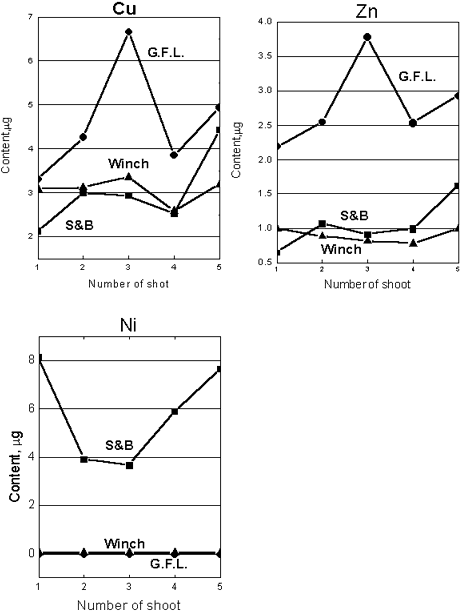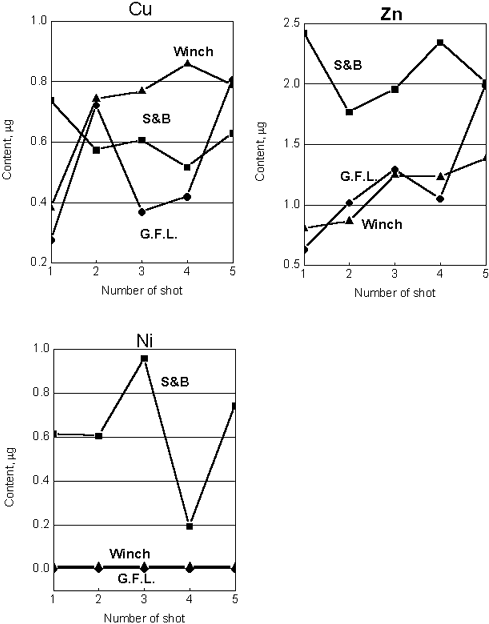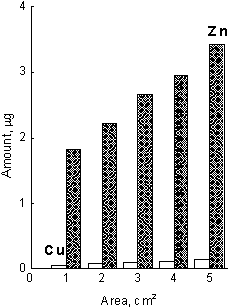The analysis of gunshot residues (GSR) in human tissues and clothing in suicide, homicide, or suspicious death provides to the forensic experts a valuable information defining used ammunition and helps to interpret an event. Atomic absorption spectroscopy was applied determining the amount of copper, zinc and nickel in entrance skin wounds and cloth injuries made by different type of jacketed bullets. The results obtained in this study showed that the size of investigated area with bullet injury, the target material and the time of extraction of metals deposit had crucial importance to the accuracy of obtained results for copper and zinc in GSR.
Introduction
The determination of gunshot residues has in resent years been concentrated on the metallic elements present in the residues. These include constituents of the primer, especially lead (Pb), antimony (Sb), barium (Ba), and as far as the target is investigated - to a lesser degree even metal traces which are abraded from the bullet during its passage through the barrel. If the bullet is jacketed, the traces of Copper/Zinc alloy (Gilding metal) or Copper/Nickel alloy (Cupronickel) may also be found on the target /1/. According to Wrobel HA et all /2/ fifty-six percent of bullets in used ammunition are plated or jacketed with Gilding metal, Cupronickel or just copper. Therefore the analysis of copper, zinc and nickel in gunshot residues on target area should make it possible to determine or exclude the type of ammunition used.
The major methods for detection of gunshot residues are neutron activation analysis (NAA) /3/, atomic absorption spectroscopy (AAS) /4,5/, chemical tests /6/ and scanning electron microscopy with energy dispersive analysis (SEM-EDA) /7/. The choice between these methods depends on the purpose of the analysis and on the availability and cost of the equipment needed. Atomic absorption spectroscopy is much less expensive method than others and can provide quantitative measurements and a sufficient sensitivity for determination of various elements in gunshot residues. This analytical method is one of the most used in forensic science laboratories /8/. On the other hand AAS do not distinguish the source of the metals and the determination of gunshot residues can be influenced by material of target. The problematic estimation of obtained GSR data arouses interpreting the results for copper and zinc due to considerable amount of these elements in human tissue. The main purpose of this experimental investigation was the evaluation of different factors that can influence the results of spectroscopic examination of copper and zinc in GSR by AAS.
Materials and method
In the experimental study, 15 shots were fired at fresh pigskin and the same number at the cotton cloth. Three kinds of full metal jacked (FMJ) bullets of
9-mm short Browning caliber ammunition were used:
S& B FMJ bullets - a plain lead core covered with a Copper/Zinc/Nickel alloy (made by Selier & Bellot);
G.F.L. FMJ bullets - a plain lead core covered with a Copper/Zinc alloy (made by Fiochi);
Winchester FMJ bullets - a plain lead core covered with a Copper/Zinc alloy containing less amount of zinc than G.F.L. (made by Winchester).
All shots were fired into the target from 50-cm distance. The object of the investigation was the area included "dirt-ring" around of the entrance hole, which was cut out from target. In parallel with each analysis the identical area from the target material without injuries was analyzed to subtract the background values from the experimental values.
Gunshot residues were extracted from target by immersing it in 10% acetic acid solution for one hour.
The amount of copper (Cu), nickel (Ni) and zinc (Zn) in the gunshot residues were examined by the method of atomic absorption spectroscopy (AAS) in the flame of air/acetylene.
Results and discussion
The each experimental study with different type of bullet was performed by making series of five shots at fresh pigskin and cotton cloth. The barrel of gun was thoroughly cleaned before each new series of shooting to eliminate the contamination of one type of bullet from previous. Fig. 1 presents results of the determination of the content of copper, zinc and nickel residues in gunshot injuries from different type of FMJ bullets on the cotton cloth and Fig.2 the same in gunshot wounds on pigskin. First off all, obtained data showed that there was no evident dependence of content of investigated metals in GSR subject to number of shoot. This result indicated that the sequence of shots can not be established on the ground of the intensity of metals residues deposited on target in "dirt-ring" area from FMJ bullets when multiple shot injuries made from the same distance occurred. The results presented in Fig. 1 and in Fig. 2 suggest that nickel residues in gunshot injuries were detected only in cases of S&B FMJ bullets (jacketed with Copper/Zinc/Nickel alloy) and this type of ammunition used can be identified among others.
The results of investigation of zinc residues in gunshot injuries of cloth demonstrated that content of zinc in gunshot residues was adequate to amount of zinc in the alloy of FMJ bullets used - the most content of zinc was found in injuries made by G.F.L. bullets, the least - made by Winchester and S&B FMJ bullets. The dependence of the content of copper in cotton cloth injuries made by different types of bullet was not such obvious as for content of zinc. The content of copper residues in injuries made by G.F.L. type bullets only slightly exceeded the content of copper residues in injuries made by S&B and Winchester FMJ bullets.
Completely different results were obtained investigating the contents of copper and zinc residues in gunshot wounds from different types of bullets (Fig. 2). The data of this study pointed out that the amount of these metals in gunshot wounds did not depend on the type of FMJ bullets. In purpose to explain such different results of GSR in cloth injuries ant skin wounds the influence of target material on obtained data was investigated.

Figure 1. Content of copper, zinc and nickel residues in gunshot injuries from different types of FMJ bullets on the cotton cloth.
 Figure 2. Content of copper, zinc and nickel residues in gunshot wounds from different types of FMJ bullets on pigskin.
Figure 2. Content of copper, zinc and nickel residues in gunshot wounds from different types of FMJ bullets on pigskin.
Fig. 3 presents the background values of copper and zinc extracted from blank cotton cloth and pigskin depending on the time of extraction. It was found that during immersion in acid solution the noticeable amount of zinc was extracted from the target of biological origin, especially when time of extraction exceeded two hours.
 Figure 3. Background values of copper and zinc extracted from A - pigskin and B - cotton cloth depending of the time of extraction.
Figure 3. Background values of copper and zinc extracted from A - pigskin and B - cotton cloth depending of the time of extraction.
The amount of zinc and copper extracted from blank pigskin were in the same value range as the content of zinc and copper residues in gunshot wounds. And even the blanks from the target materials are often subtracted from experimental values the considerable amount of zinc and copper in target of biological origin appears to have great influence upon the possibility to identify the type of FMJ bullet used. In this matter only the conclusion that FMJ bullet with nickel content in jacked or without it was used are possible.
The data from Fig. 3B indicate that amount of zinc and copper extracted from blank cotton cloth did not depend in obvious manner on the time of extraction and had rather the origin from contamination of fabric by these elements. On the other hand the amount of these elements in blank cotton cloth target not exceed the content of copper and zinc residues in cloth injuries (Fig. 1) and so did not influence the possibility to distinguish the type of FMJ bullets made injuries.
Additionally it was investigated the background values of zinc and copper extracted from pigskin depending upon cut out area from the target. The results of this study are presented in Fig. 4.

Figure 4. Background values of copper and zinc extracted from pigskin depending on the cut out area.
It was found that amount of zinc and copper increase uniformly with increasing cut out area. Therefore it is in great importance to select the optimal area of target with bullet injury.
Conclusion
The performed experimental investigation showed that the elemental composition of GSR in bullet injuries allowed distinguishing the type of ammunition. Gunshot residues on cloth injuries were preferable objects for this purpose. The accuracy of determination depended on the size of investigated area around the injury, on the target material and on the time of extraction of metals deposit.
References
Maehly A, Stromberg L. Chemical Criminalistics. SPRING VERLAG; NY, 1981: 183-200.
Wrobel HA, Millar JJ, Kijek M: Identification of ammunition from gunshot residues and other cartridge related materials - a preliminary model using. 22 caliber rimfire ammunition. J Forensic Sci 1998; 43(2): 324-328.
Rudzitis E, Walgren M: Firearm residue detection by instrumental neutron activation analysis. J Forensic Sci 1975; 20: 119-124.
Krishnan SS: Detection of gunshot residues on the hands by neutron activation analysis and atomic absorption analysis: J Forensic Sci 1974a; 19: 789-797.
Ravreby M: Analysis of long-range bullet entrance holes by atomic absorption spectrophotometry and scanning electron microscopy: J Forensic Sci 1982;27:92-112.
6. Lekstrom JA, Koons RD: Copper and nickel detection on gunshot targets by dithiooxamide test. J Forensic Sci 1986;31:1283-1291.
DiMaio VJ, Dana SE, Taylor WE, Ondrusek J: Use of scanning electron microscopy and energy dispersive X-ray analysis (SEM-EDXA) in identification of foreign material on bullets. J Forensic Sci 1987; 32:38-47.
Encyclopedia of forensic sciences. Ed. Siegel J. ACADEMIC PRESS; NY, 2000: 953-961.
Список литературы
1.Maehly A, Stromberg L. Chemical Criminalistics. SPRING VERLAG; NY, 1981: 183-200.
2.Wrobel HA, Millar JJ, Kijek M: Identification of ammunition from gunshot residues and other cartridge related materials - a preliminary model using. 22 caliber rimfire ammunition. J Forensic Sci 1998; 43(2): 324-328.
3.Rudzitis E, Walgren M: Firearm residue detection by instrumental neutron activation analysis. J Forensic Sci 1975; 20: 119-124.
4.Krishnan SS: Detection of gunshot residues on the hands by neutron activation analysis and atomic absorption analysis: J Forensic Sci 1974a; 19: 789-797.
5.Ravreby M: Analysis of long-range bullet entrance holes by atomic absorption spectrophotometry and scanning electron microscopy: J Forensic Sci 1982;27:92-112.
6. Lekstrom JA, Koons RD: Copper and nickel detection on gunshot targets by dithiooxamide test. J Forensic Sci 1986;31:1283-1291.
7.DiMaio VJ, Dana SE, Taylor WE, Ondrusek J: Use of scanning electron microscopy and energy dispersive X-ray analysis (SEM-EDXA) in identification of foreign material on bullets. J Forensic Sci 1987; 32:38-47.
8.Encyclopedia of forensic sciences. Ed. Siegel J. ACADEMIC PRESS; NY, 2000: 953-961.


 Федеральное государственное бюджетное учреждение науки
Федеральное государственное бюджетное учреждение науки

